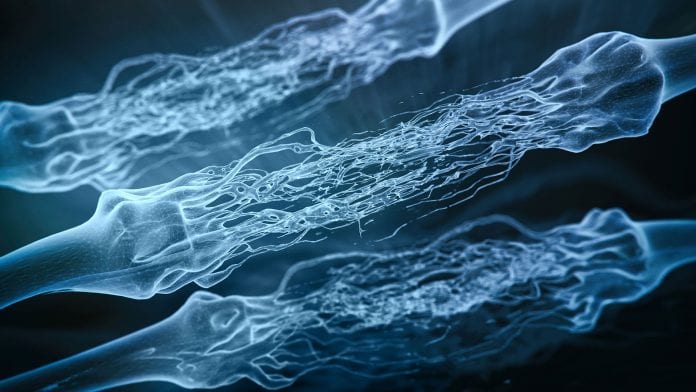
A groundbreaking study has identified an important mechanism that can be used to control the restoration of myelin sheaths in patients with degenerative diseases, such as multiple sclerosis and following traumatic injuries.
The researchers at Johannes Gutenberg University Mainz (JGU) and the University of Fribourg in Switzerland and led by neurobiologist Professor Claire Jacob, were able to regenerate damaged myelin sheaths in mice by treating them with the active substance theophylline, restoring their nerve cell function. This research could have huge implications for people with multiple sclerosis who have damaged myelin sheaths.
The paper has been published in Nature Communications.
Restoring protective myelin coating
Intact myelin sheaths are a prerequisite for the healthy functioning of the peripheral and central nervous systems. The research group investigated how remyelination occurs in both peripheral and central nervous systems of mice.
“First, we wanted to understand the process that blocks remyelination. We subsequently studied how to counteract this blocking effect,” said Jacob. The neuroscientists identified a protein called eEF1A1 as a key factor in the process and found that eEF1A1 activated by acetylation prevents the remyelination process, but if eEF1A1 is deactivated by deacetylation, myelin sheaths can be rebuilt. The protein that deacetylates eEF1A1 is the enzyme called histone deacetylase 2 (HDAC2).
“Once we understood this process, we decided to try to control it by boosting the HDAC2 activity and its synthesis in cells,” said Jacob. This was achieved by using the active substance theophylline, which is also present in tea leaves and has long been used in the treatment of asthma.
“In a mouse model, the use of theophylline over a period of four days resulted in significant recovery. Restoration of myelin sheaths was particularly impressive in the PNS, where they recovered completely. Regeneration also improved in the CNS, as there was rapid and efficient rebuilding of myelin sheaths in both young and old mice. A low dose of the active substance was sufficient to trigger the improvements – a big plus with regard to the known side effects of theophylline, which occur at higher doses.
“In summary, this study […] shows that theophylline, by activating HDAC2, promotes eEF1A1 deacetylation, increases […] remyelination speed and efficiency after lesion of the PNS and CNS, thus appearing as a very promising compound to test in future translational studies to accelerate and promote remyelination after traumatic lesions or in the context of demyelinating disorders,” write the authors.
Funding for corresponding clinical trials in patients is now being sought, while a patent application has already been filed.










Please please can I take part in trial I’ve had RRMS for 31 years have 22 leisons in brain and 2 in neck am now SPMS
I want to participate in the research to rebuild myelin on the nerves. It give me hope for my vision thanks
Please select me for the clinical trial. I have had ms for 5 years affected my right side of the body
My name is Jason mobile and I have multiple sclerosis I’ve had Ms for 5 years I would like to be considered for the trial please contact me